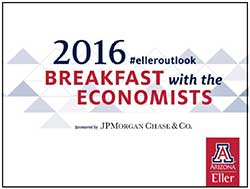EBRC Director George Hammond and Milken Institute Chief Research Officer Ross DeVol shared details at June 1 Breakfast with the Economists
Download presentation from this year’s event held June 1, 2016 at the Westin La Paloma in Tucson.
TUCSON, Ariz. – June 1, 2016 – Tucson’s economy is poised for significant growth over the next two years. That was a key message during today’s University of Arizona Eller College of Management 2016 Breakfast with the Economists event at the Westin La Paloma Resort in Tucson.
More than 400 people attended the event to hear presenters George W. Hammond, Ph.D., director and research professor at UA Eller’s Economic and Business Research Center, and Ross DeVol, chief research officer of the Milken Institute, discuss the latest data and share predictions for local job growth, the housing sector, trade and export activity, the impact of education on local economic growth and more.
Hammond, who predicted in December 2015 that Tucson’s job growth would gradually improve, said Tucson job growth is finally beginning to pick up steam.
“Tucson continued to expand at a modest pace last year, but recent results suggest a significant acceleration,” Hammond said. “Further, the forecast calls for recent momentum to build toward stronger performance during the next two years.”

George W. Hammond, Ph.D.
Hammond’s presentation revealed that:
- Job growth in the Tucson metropolitan statistical area (MSA) averaged 2.8 percent over the year in the first three months of 2016. That translated into 10,400 additional jobs, according to the preliminary data. That was much faster than the 0.8 percent (2,900 jobs) increase that the local area posted last year.
- Most of the job gains over the year were in education and health services, financial activities, and professional and business services, with smaller increases in government (primarily state and local), manufacturing, leisure and hospitality, information, and trade, transportation, and utilities.
- Natural resources and mining and other services lost jobs. Declining copper prices drove the losses in mining.
- Population gains were modest last year, with the region adding just 2,200 residents. However, with stronger job growth expected for 2016, population gains may pick up additional steam. That would boost housing permit activity from relatively weak levels in 2015 to better performance during the next few years.
- Tucson’s job growth is forecast to accelerate from 0.8 percent last year to 1.7 percent in 2016, and to 1.9 percent in 2017. Population growth increases from 0.2 percent in 2015 to 0.6 percent this year and then to 1.0 percent in 2017.
“Overall, if the national economy continues to expand, Tucson is well positioned to grow, and to grow at a faster pace,” Hammond said. “However, there are risks to the outlook to consider. These include, but are not limited to, a national or global downturn, continued low U.S. residential mobility, and a major fiscal shock affecting the government sector.”
DeVol’s presentation focused on the characteristics of competitive places and the critical role of human capital. Guests heard about the Milken Institute’s new research, which displays the relationship between educational attainment and economic performance across 261 metropolitan economies in the U.S.
“We took into account the average years of schooling, age composition of the workforce, industry mix, R&D intensity as measured by patents per capita, and other structural differences,” DeVol said. “We found that adding one year of schooling to the average educational attainment among employed workers with at least a high school diploma is associated with an increase in real GDP per capita of 17.4 percent and an increase in real wage per worker of 17.8 percent.”

Ross DeVol
DeVol’s presentation covered several key points:
- The factors that are critical for regional economic success are changing and the role of human capital is becoming ever more important. Labor is highly mobile between U.S. regions as individuals and firms respond to differences in relative economic-performance factors. Migration trends between states and regions, however, can greatly alter their long-term potential growth rates. Today, concentrations of talent attract firms to states as opposed to industry agglomerations and firms being the principal attraction force for people.
- Since 1980, the average years of schooling among Americans 15 and older increased by 1.1 years, to 13.1 years in 2010. However, many nations are closing the gap. Other advanced economies gained 2.4 years, reaching 10.6 years of schooling over the same period.
- Tucson ranks the highest among Arizona’s metros in terms of education attainment. However, Tucson’s ranking has slipped from 62nd in 1990 to 90th in 2010 in the percent of the workforce with a bachelor’s degree or above among 261 metros.
- Arizona’s ranks 29th on human capital measures for states. Arizona performs well in attracting skilled labor from outside the state, but falls short of where it needs to be in creating its home-grown human capital.






